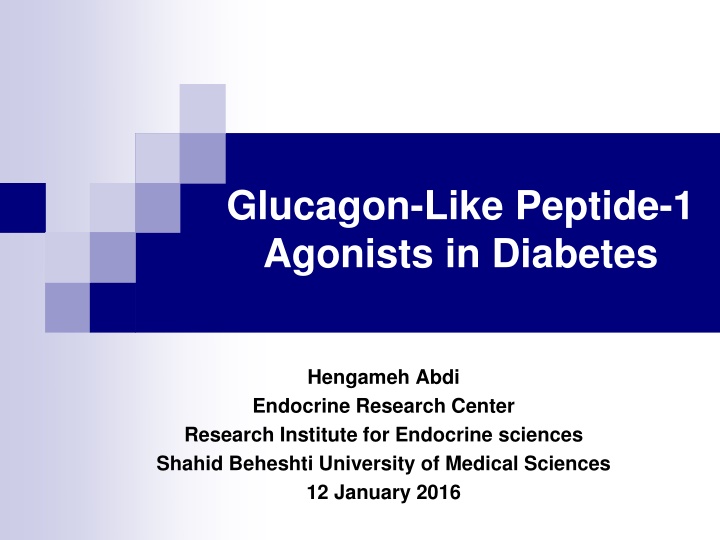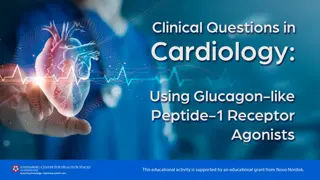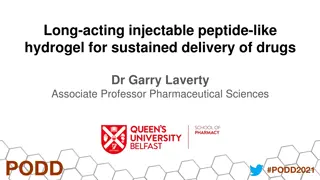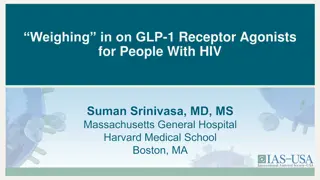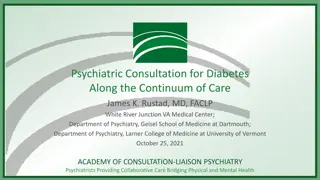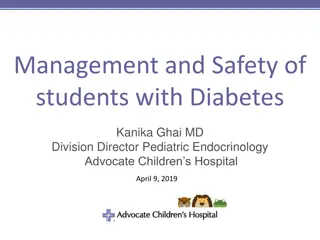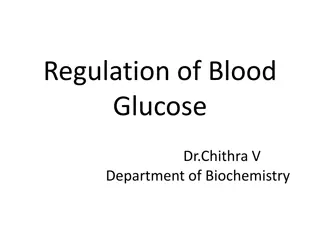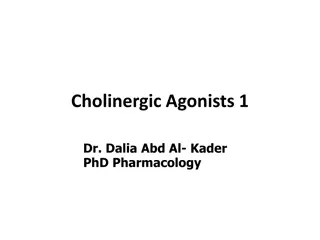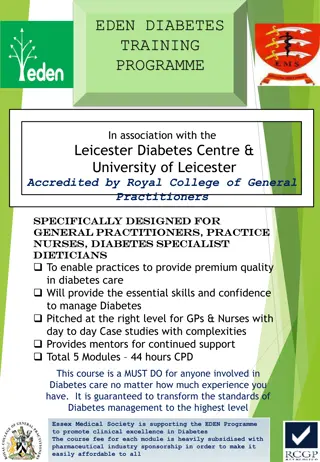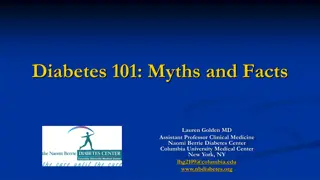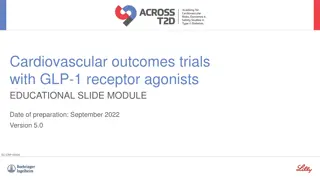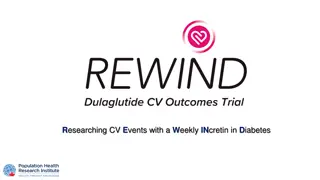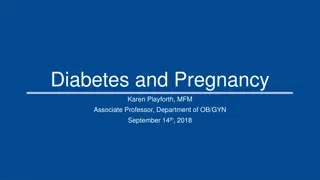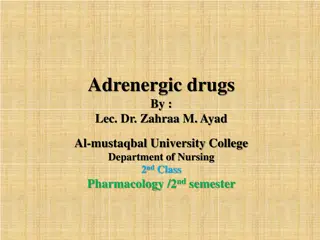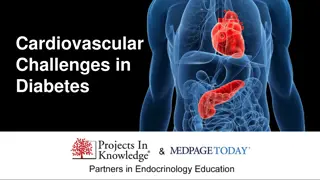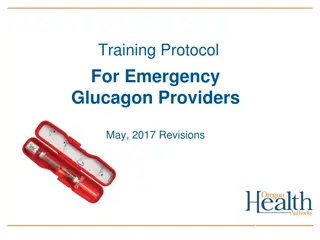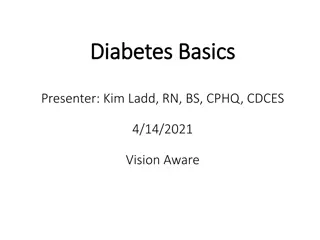Glucagon-Like Peptide-1 Agonists in Diabetes
Understanding the role of GLP-1 agonists in diabetes management, focusing on efficacy, cardiovascular safety, and position in ADA standards. Explore the actions on different target tissues, comparison with other glucose-lowering drugs, and the impact of Liraglutide. Delve into the LEAD studies showcasing the effectiveness of Liraglutide in glycemic control and weight reduction.
Download Presentation

Please find below an Image/Link to download the presentation.
The content on the website is provided AS IS for your information and personal use only. It may not be sold, licensed, or shared on other websites without obtaining consent from the author.If you encounter any issues during the download, it is possible that the publisher has removed the file from their server.
You are allowed to download the files provided on this website for personal or commercial use, subject to the condition that they are used lawfully. All files are the property of their respective owners.
The content on the website is provided AS IS for your information and personal use only. It may not be sold, licensed, or shared on other websites without obtaining consent from the author.
E N D
Presentation Transcript
Glucagon-Like Peptide-1 Agonists in Diabetes Hengameh Abdi Endocrine Research Center Research Institute for Endocrine sciences Shahid Beheshti University of Medical Sciences 12 January 2016
Outlines Biology of GLP-1 GLP-1 agonist formulations Comparison with other glucose-lowering drugs Focus on Liraglutide Efficacy Cardiovascular safety (LEADER trial) Safety of GLP-1 agonists Position of GLP-1 agonists in ADA standards of medical care in diabetes Conclusions 2
GLP-1 Actions on Different Target Tissues 3 Drucker DJ. Cell Metab 2006;3(3):153-65.
Various GLP-1 Agonists Short-acting: Exenatide (53% homology with human GLP) Twice-daily injection Lixisenatide (50% homology with human GLP) Once-daily injection Long-acting: Liraglutide (97% homology with human GLP) Once-daily injection Exenatide (sustained-release) Once-weekly injection Albiglutide, Dulaglutide, Semaglutide Once-weekly injection 4
Comparison of Noninsulin Antidiabetic Drugs added to Metformin-Position of GLP-1 Agonists 1.76 ( 2.90 to 0.62) 0.99 ( 1.19 to 0.78) 5 Phung OJ, et al. JAMA 2010;303(14):1410-18.
Liraglutide Effect and Action in Diabetes (LEAD) Studies A series of 6 randomized controlled studies (duration of 26 wk except LEAD-3 which was 52 wk) involving more than 4400 patients with type 2 diabetes who were unable to maintain glycemic control with diet and exercise alone or with oral treatment, 2700 of whom received liraglutide. The studies demonstrated the efficacy and safety of liraglutide both as monotherapy and as combination therapy with 1 or 2 oral agents. Liraglutide reduced weight in most patients, improved -cell function, lowered blood pressure and triglycerides, and was well tolerated with minimal risk of hypoglycemia. 7 McGill JB. Postgrad Med 2009;121(3):16-25.
Compared with control (placebo, sitagliptin, glimepiride, dulaglutide, insulin glargine, and NPH), liraglutide in combination with metformin resulted in significant reductions in HbA1c-Meta-analysis of RCTs 8 Gu J, et al. Scientific Reports 2016 Sep 7;6:32714
Compared with control (placebo, sitagliptin, glimepiride, dulaglutide, insulin glargine, and NPH), liraglutide in combination with metformin resulted in significant reductions in body weight 9 Gu J, et al. Scientific Reports 2016 Sep 7;6:32714
Treatment-related adverse events Compared with control (placebo, sitagliptin, glimepiride, dulaglutide, insulin glargine, and NPH), liraglutide added to metformin, Did not increase the risk of hypoglycemia. (RR = 0.33, 95% CI: 0.08, 1.44; P = 0.14) Increased the risk of gastrointestinal disorders. (RR = 1.59, 95% CI: 1.15, 2.19; P = 0.005) No cases of pancreatitis were reported in these included studies. Gu J, et al. Scientific Reports 2016 Sep 7;6:32714 10
Cardiovascular Effects of GLP-1 Agonists FDA issued an updated guidance for industry in 2008 requiring that preapproval and postapproval studies for all new antidiabetic drugs rule out excess cardiovascular risk. FDA/CDER Dec 2008. 11
There is no increased risk of MACE (Major Adverse Cardiac Event) with GLP-1 agonists relative to controls in the short term. a Primary endpoint: MACE composite endpoint or hospital admission for unstable angina. b Secondary endpoint: MACE composite endpoint only. c Secondary MACE composite endpoint, which included all relevant CV AEs [i.e., all terms of the primary MACE endpoint plus terms for arrhythmia, heart failure (with or without hospitalization), and mechanical-related events]. 12 Mannucci E, Monami M. Adv Ther 2017.34:1-40
Liraglutide Effect and Action in Diabetes: Evaluation of Cardiovascular Outcome Results (LEADER) Marso SP, et al. N Engl J Med 2016;375(4):311-22. 13
The LEADER trial was designed to investigate the cardiovascular profile of liraglutide versus placebo in addition to standard care. 14
MACE: major adverse cardiovascular events 3-point MACE: cardiovascular death, non-fatal myocardial infarction and non-fatal stroke 15
In the liraglutide group, cardiovascular death decreased significantly (22%); The frequencies of nonfatal myocardial infarction and nonfatal stroke were also lower, although the differences were not significant. 16
LEADER Summary Liraglutide significantly reduced the risk of the primary composite cardiovascular (CV) outcome by 13% vs placebo. Compared with placebo, liraglutide also significantly reduced the risk of CV and all-cause death (22% and 15% reduction, respectively). Liraglutide resulted in greater reductions in HbA1c[-0.40% (95% CI, - 0.45 to -0.34)], body weight [-2.3 kg (95% CI, -2.5 to -2.0)] and systolic blood pressure [-1.2 mmHg (95% CI, -1.9 to -0.5)] vs placebo. Liraglutide was associated with a higher frequency of adverse events leading to permanent treatment discontinuation. 18
Safety and Tolerability of GLP-1 Agonists 19
Gastrointestinal Adverse Events The most common side effect of GLP-1 agonists. Tend to occur early in treatment and subside over time. Nausea, vomiting, diarrhea. Nausea: 8-40% more than placebo or active comparator. Diarrhea: 3-118% more than placebo or active comparator. Nausea can be reduced with dose titration. Nausea occurs less frequently with exenatide once weekly than exenatide twice daily or liraglutide. Shyangdan DS, et al. Cochrane Database Syst Rev 2011. Madsbad S. Diabetes Obes Metab 2016;18:317 332. 20
Pancreatitis A meta-analysis including 41 RCTs (8353 patient x years total exposure for GLP agonists): The overall risk of pancreatitis was not different between GLP-1 agonists and comparators (OR: 1.01 [0.37; 2.76]; p = 0.99). A meta-analysis considering pancreatitis risk of incretin-based treatments: 29 RCTs (14,562 patients) compared GLP-1 agonists vs control: 16 pancreatitis events (0.11%); (OR 1.05 [0.37-2.94]) Monami M, et al. Diabetes Res Clin Pract 2014;103:269-275. Li L, et al. BMJ 2014;348:1-19 21
Pancreatitis The available evidence suggests that the incidence of pancreatitis among patients using incretins is low and that the drugs do not increase the risk of pancreatitis. Current evidence, however, is not definitive, and more carefully designed and conducted observational studies are warranted to definitively establish the extent, if any, of increased risk. Monami M, et al. Diabetes Res Clin Pract 2014;103:269-275. Li L, et al. BMJ 2014;348:1-19. 22
Liraglutide appeared to have a safe and well- tolerated profile in the LEADER trial. 18/4668 vs 23/4672 Marso SP, et al. N Engl J Med 2016 375(4):311-22. 23
Precautions when prescribing Victoza (liraglutide) Victoza is contraindicated in patients with a personal or family history of medullary thyroid carcinoma or Multiple Endocrine Neoplasia syndrome type 2 (MEN 2). Victoza should be used with caution in patients with a history of pancreatitis. No dose adjustment of Victoza is recommended for patients with renal impairment. FDA Victoza prescribing information Updated 2012. 24
GLP-1 Agonists in Recent American Diabetes Association Standards of Medical Care in Diabetes 25
26 ADA. Diabetes Care 2017;40(Suppl 1)
In patients with long-standing suboptimally controlled type 2 diabetes and cardiovascular disease, empagliflozin or liraglutide should be considered as they have been shown to reduce cardiovascular and all-cause mortality when added to standard care. (Level of evidence B) established atherosclerotic ADA. Diabetes Care 2017;40(Suppl 1) 27
Concluding Remarks GLP-1 agonists affect glucose control through several mechanisms: Enhancement of glucose-dependent insulin secretion Slowed gastric emptying Regulation of postprandial glucagon Reduction of food intake They do not usually cause hypoglycemia in the absence of therapies that otherwise cause hypoglycemia. 28
Concluding Remarks GLP-1 agonists can be prescribed in combination with metformin (and/or another oral agent) also basal insulin for patients who fail initial therapy, particularly when weight loss or avoidance of hypoglycemia is a primary consideration, the HbA1c is close to target (within 1 to 1.5 percentage points), and cost is not a major barrier. A prior history of atherosclerotic cardiovascular disease might favor choosing liraglutide as the second drug to be added to metformin. 29
Concluding Remarks The gastrointestinal, particularly nausea and diarrhea. side effects of GLP-1 agonists are predominantly There are few long-term studies of GLP-1 agonists to assess clinically important health outcomes mortality), durability of glucose control or weight loss, or safety. (cardiovascular events, Many questions remain unanswered regarding clinical use in type 2 diabetes, including long-term benefits and risks and their role in combination with other diabetes medications. 30
Thanks for your patience! Admission for at least 72 hours Serum : DW5% 100 cc / h saline for hydration
